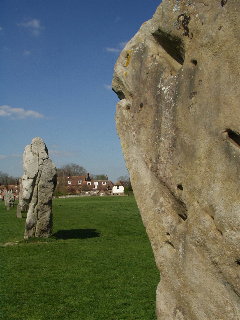Stigma (A Ghost Story for Christmas)
| "Stigma" | |
|---|---|
| A Ghost Story for Christmas episode | |
 Title screen | |
| Episode no. | Episode 7 |
| Directed by | Lawrence Gordon Clark |
| Written by | Clive Exton |
| Produced by | Rosemary Hill |
| Original air date | 29 December 1977 |
| Running time | 32 minutes |
| Guest appearances | |
| |
"Stigma" is a short film which serves as the seventh episode of the British supernatural anthology television series A Ghost Story for Christmas. Written by Clive Exton, produced by Rosemary Hill, and directed by the series' creator, Lawrence Gordon Clark, it first aired on BBC1 on 29 December 1975 (delayed from 28 December), the latest airdate in the series relative to Christmas.
The story concerns a family consisting of Katharine (Kate Binchy), Peter (Peter Bowles), and Verity (Maxine Gordon) who move to a rural cottage from the city. Workmen are brought in to try and remove a large stone which is embedded in the grass outside the cottage, but their attempts appear to unleash a supernatural force which causes Katharine to start bleeding from invisible wounds.
Stigma is the first instalment in the series not based on a pre-existing work, and the last to be directed by Clark. Hill, who had been brought on as producer in 1973, favoured contemporary stories as opposed to the period adaptations which had been the norm for the series. Clark's ambivalence to this direction led to his departure, and the series' original run would only last another year before ending. Critical and audience response was likewise negative, though in recent years it has been reassessed as a worthy piece of folk horror and body horror that stands alongside supernatural television plays of the decade such as those produced for Play for Today.
Plot[edit]
The film concerns a family who have just moved into a cottage in the countryside. The cottage is situated near an ancient megalithic stone circle, and one of the stones is in the garden of the cottage. The family arranges to have the stone moved. However, as two workmen attempt to lift a large, heavy stone from their garden, an ancient curse is unleashed which causes the mother to bleed uncontrollably, despite having no wounds. Once the stone is finally moved, a skeleton is found buried there. The implication is that the mother's body is re-enacting the ritual execution of a witch who was buried under the stone centuries earlier.[1]
Production[edit]

The production was filmed at Avebury, Wiltshire, which had also been the location used for the ITV series Children of the Stones (screened earlier the same year). The production is unlike the previous films in the Ghost Story For Christmas strand in several ways; it is the first to be an original story and the first to be set in the then-present day. Critical opinion is decidedly mixed, with the decision to move away from adaptations of classic ghost stories the main concern. David Kerekes, author of Creeping Flesh: The Horror Fantasy Film Book: Volume 1, suggested that "the problem is that this is not a ghost story. Stigma is a straight down the line horror story. Although it's a perfectly competent television production, it just doesn't fit in with the feel of what a Christmas ghost story should be."[2]
Cast[edit]
- Kate Binchy as Katharine
- Peter Bowles as Peter
- Maxine Gordon as Verity
- Jon Laurimore as Dr. Hall
- Christopher Blake as Richard
- John Judd as Dave
Home media[edit]
"Stigma" was released on DVD by the British Film Institute in 2012. It was released on a single disc along with two other films from the Ghost Story for Christmas strand; "The Signalman" and "The Ice House". The DVD also contains bonus features including a 9-minute introduction to "Stigma" by director Lawrence Gordon Clark, and a booklet containing newly commissioned essays about the productions. It was also included in a boxed set of all of the BBC's Ghost Stories for Christmas, released by the BFI the same year. A new HD master of the piece was released on the second Blu-ray edition of the parent strand in 2023.
